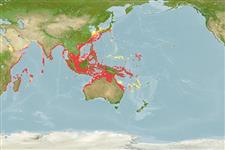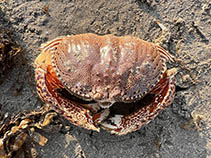Calappa lophos (Herbst, 1785)
Common box crab| Native range | All suitable habitat | Point map | Year 2050 |

|
| This map was computer-generated and has not yet been reviewed. |
| Calappa lophos AquaMaps Data sources: GBIF OBIS |
Classification / Names Common names | Synonyms | CoL | ITIS | WoRMS
Malacostraca | Decapoda | Calappidae
Environment: milieu / climate zone / depth range / distribution range Ecology
Reef-associated; depth range 10 - 100 m (Ref. 343). Tropical; 38°N - 28°S, 33°E - 171°E
Distribution Countries | FAO areas | Ecosystems | Occurrences | Introductions
Indo-Pacific: Japan to Southeast Asia, Australia to Sri Lanka.
Length at first maturity / Size / Weight / Age
Maturity: Lm ? range ? - ? cm Max length : 10.0 cm CW male/unsexed; (Ref. )
Short description Morphology
Clypeiform posterolateral part of carapace with strong lateral projections. Ground color yellowish beige to yellow; posterior 1/3 of carapace with distinct red spots, posterolateral part with transverse red stripes; outer surface of cheliped with red streaks and spots.
Sandy-muddy area. Burrows body on soft and mud substrates (Ref. 343). In general, Calappa feeds upon molluscs and hermit crabs in gastropod shells. Their right claw is used for crushing shells of prey while their left claw is used as a cutter (Ref. 105092).
Life cycle and mating behavior Maturity | Reproduction | Spawning | Eggs | Fecundity | Larvae
Members of the order Decapoda are mostly gonochoric. Mating behavior: Precopulatory courtship ritual is common (through olfactory and tactile cues); usually indirect sperm transfer.
Main reference
References | Coordinator | Collaborators
Ng, P.K.L. 1998. (Ref. 343)
IUCN Red List Status (Ref. 130435)
CITES status (Ref. 108899)
Not Evaluated
CMS (Ref. 116361)
Not Evaluated
Threat to humans
Harmless
Human uses
| FishSource |
Tools
More information
Internet sources
BHL | BOLD Systems | CISTI | DiscoverLife | FAO(Publication : search) | Fishipedia | GenBank (genome, nucleotide) | GloBI | Gomexsi | Google Books | Google Scholar | Google | PubMed | Tree of Life | Wikipedia (Go, Search) | Zoological Record
Estimates based on models
Preferred temperature
(Ref. 115969): 24.2 - 29.1, mean 28 (based on 1654 cells).
Price category
(Ref. 80766):
Unknown.



